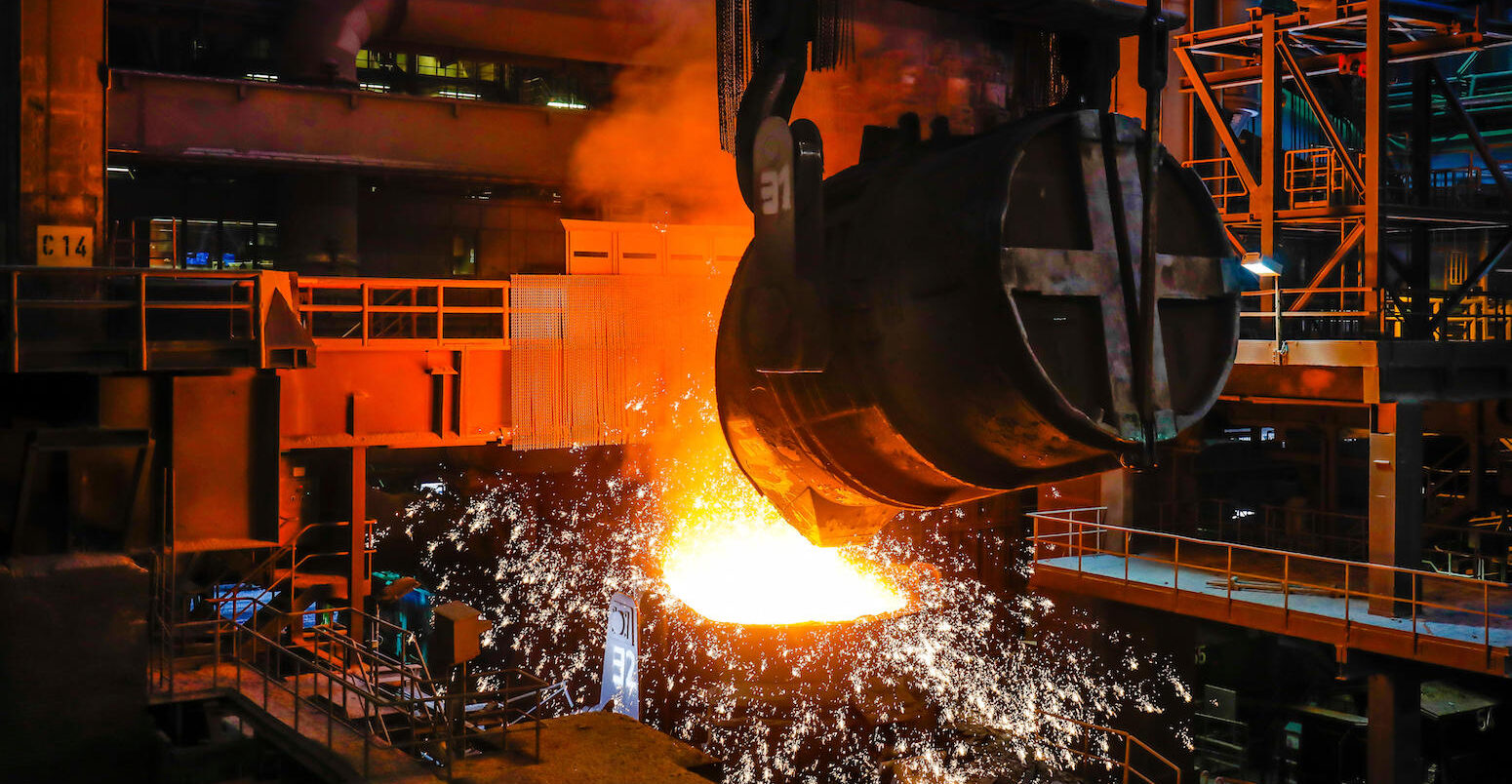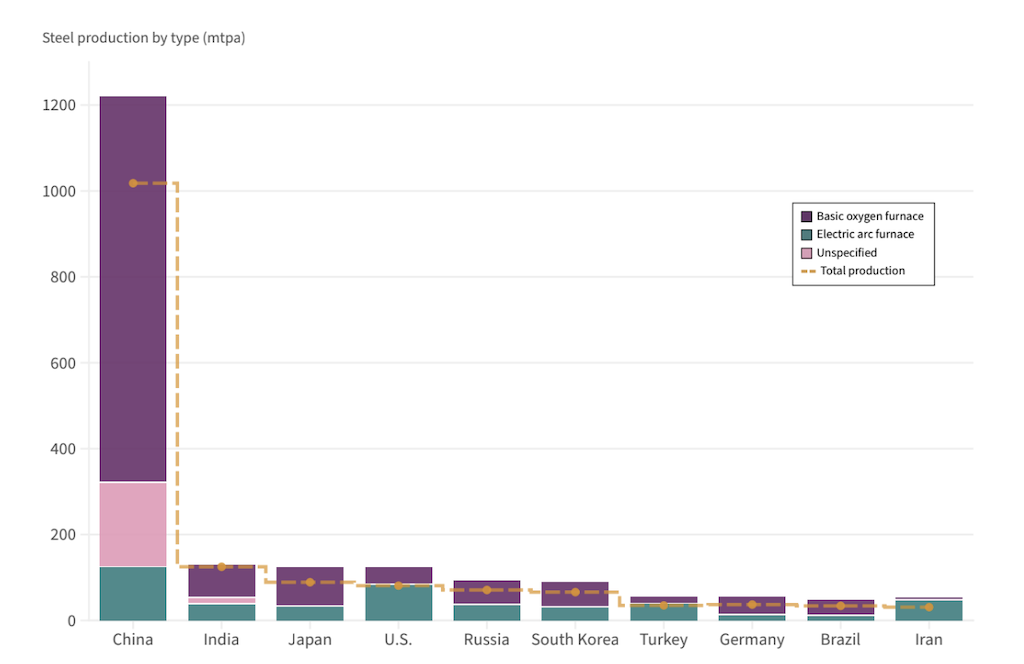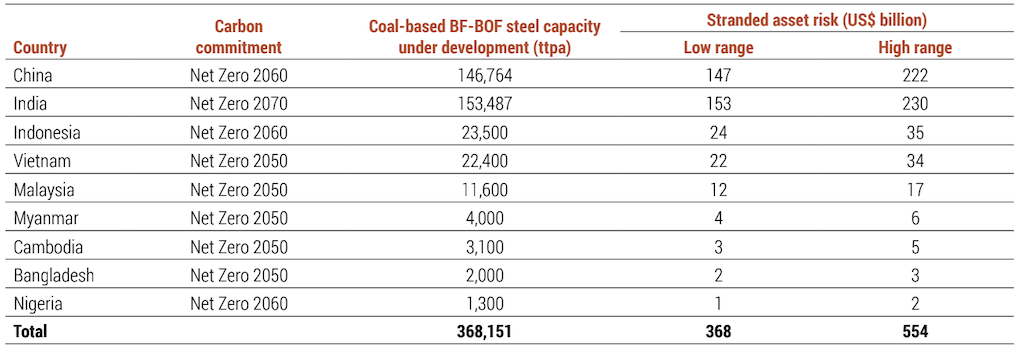
Steel industry makes ‘pivotal’ shift towards lower-carbon production
Molly Lempriere
07.20.23Molly Lempriere
20.07.2023 | 12:01amThe steel industry has made a ‘pivotal’ shift towards lower-carbon forms of production, a new report says, but remains short of a 1.5C-compatible pathway.
The new report from Global Energy Monitor (GEM) shows that 43% of planned steelmaking capacity is now based on electric arc furnace (EAF) technology, while 57% would use coal-based blast furnace-basic oxygen furnaces (BF-BOF).
This marks a key change from a year earlier, according to GEM, when just 33% of planned capacity was set to use EAF against 67% using BF-BOF. The report says this marks a “pivotal” shift for the industry:
“The last year was pivotal for heavy industry decarbonisation. Steel has moved from inertia to progress.”
Despite this shift, the industry is falling short of what would be needed to keep warming below 1.5C, GEM notes, pointing to the International Energy Agency (IEA) Net Zero by 2050 scenario. This calls for over half (53%) of steelmaking capacity to use EAF by 2050.
Additionally, the IEA scenario calls for the slashing of coal-based capacity, retiring or cancelling 347m tonnes (Mt). In contrast, the capacity of coal-based steelmaking projects under development grew by 8% in the year ending March 2023, GEM says.
The report highlights that to avoid long-term carbon lock-in and minimise stranded asset risk, no further reinvestments should be made in BF steelmaking by 2025.
Steel decarbonisation fails to keep pace
Over the past year, there has been a notable shift in the proportions of coal-based and lower-carbon forms of planned steelmaking capacity, says GEM.
In March 2022, planned new steelmaking capacity mirrored the world’s existing fleet, with 67% BF-BOF in planning and 68% BF-BOF in operation, versus 33% of EAF in planning and 32% of EAF in operation.
However, as of March 2023, some 57% of planned capacity was BF-BOF and 43% was largely gas- and electricity-based EAF, the report finds. This is a “significant” shift, GEM says, adding that it shows the industry is starting to face “the reality of decarbonisation”.
There has been a 68% increase in the number of EAF developments announced over the last year, with 286m tonnes per year (Mtpa) of capacity under development compared with just 170Mtpa a year earlier.
Of the new development capacity announced before 2021, 78% uses BF-BOF technology and 22% uses EAF. Since 2021, 48% uses BF-BOF and 52% uses EAF.
A shift can be seen in operating capacity too, according to GEM. In its earlier report covering the period up to March 2021, some 68% of operating capacity was using BF-BOF, 31% EAF and less than 1% open hearth furnace. Since then, 57% of the projects that have come online have been BF-BOF and 43% EAF.
But despite this shift in both new developments and operating capacity, the industry is still far from the timeline needed to meet the IEA’s 53% EAF threshold by 2050, says GEM.
Taking into account a projected 12% increase in global steel demand by 2050, approximately 347Mtpa of BF-BOF capacity would need to be retired or cancelled, and around 610Mtpa of EAF capacity added, in order to meet the IEA’s 53% threshold.
To get on track with this timeline, existing BF-BOF capacity should be retired, capacity under development should be cancelled and BF-BOF plans should be replaced with alternative technologies, mainly direct reduced iron EAF, according to the report.
While the growth of EAF is generally considered a positive sign for the shift towards lower-carbon steel, the carbon intensity of production also depends on the source of electricity used to drive the process and the type of iron feedstock.
Annual steel emissions ‘must halve by 2030’
Collectively, the iron and steel industry account for 11% of global carbon emissions and 7-9% of global greenhouse emissions.
Steel sector emissions have averaged approximately 3.7bn tonnes of carbon dioxide (GtCO2) per year since 2019, according to GEM calculations. This is more than all the passenger cars on Earth.
According to GEM’s Global Steel Plant Tracker (GSPT) – which covers 92% of global steelmaking capacity – some 62% (1,397Mtpa) of current global crude steel capacity uses BOF, 29% (665Mtpa) uses EAF and <1% (<6Mtpa) uses “open hearth” furnaces.
Approximately 86% of steel emissions came from BF-BOF production, and 15% from EAF production, according to a benchmarking report from 2022.
(Accounting for methane emissions from the metallurgical coal mining sector could further increase the reported carbon footprint of the steel industry by up to 27%.)
To align with the IEA’s Net Zero by 2050 scenario for 1.5C, direct emissions from the iron and steel industry would need to fall to 1.8GtCO2 by 2030 and 0.2GtCO2 by 2050.
In 2020, as the Covid-19 pandemic hit, steel demand fell by 0.2% according to the World Steel Association, before bouncing back by 2.8% in 2021. The war in Ukraine and challenges around inflation led demand to again contract in 2022, by approximately 2.3%.
Demand for steel is expected to grow by 2.3% to reach 1,822.3Mt in 2023, and again by 1.7% in 2024 to reach 1,854Mt, according to the World Steel Association. To cut emissions while meeting increases in global demand, the industry will have to shift towards low-carbon forms of production.
The GEM report notes that while the inclusion of carbon capture utilisation and storage (CCUS) is “critical” in this transition, it is “essential to exercise caution” in order to prevent steelmakers from investing more in carbon-intensive production, given CCUS alone cannot serve as a “comprehensive decarbonisation solution” for the industry.
But if reinvestment in BF steelmaking capacity were to continue beyond 2025, the only possible way for the sector to reach net-zero in line with the IEA pathway would be “major breakthroughs” in CCUS, Caitlin Swalec, programme director for heavy industry at GEM and lead author of the report tells Carbon Brief. She says:
“This means that CCS/CCUS becomes viable at commercial scale and widely implemented. The IEA pathway leaves room for no more than 5% of BF-BOFs to operate unabated by 2050. As of now, there is no CCS/CCUS successfully operating at the commercial scale at a steel plant.”
Overcapacity could be leveraged
Overcapacity remains a significant issue within the steel industry, with capacity exceeding demand by 26% globally (632Mt) in 2022, according to the OECD.
This overcapacity is largely driven by “market-distorting government subsidies and support measures” the OECD says, which keep inefficient steelmakers operating.
Removing the subsidies could both lead to a healthier steel market, benefiting the industry at large, and help close the gap in production costs between BF-BOF and lower-emissions processes, Swalec tells Carbon Brief.
With China dominating the market, its market strategy has a particularly strong impact. Chris Bataille, adjunct research fellow at the Columbia University Center on Global Energy Policy and lead author at the global Net Zero Steel project. He tells Carbon Brief:
“What’s happened is more than half the steel in the world is now made in China. And they have both some of the older, less efficient plants, but a lot of very efficient plants. But the way they’ve structured their industries, they always have slightly more capacity than they do production than they do have demand, which means that about 3, 4, 5% of their steel gets put on global markets, which then depresses the price, which then sets up this stage of global overcapacity.”
The gap between supply and demand narrowed in 2021 to 544Mt from 620Mt in 2020, however excess capacity has remained at or around 25% since 2018.
Current development plans and investments in new crude steelmaking capacity sit at 736Mtpa, according to the 2023 GSPT, suggesting that this trend of overcapacity will continue, unless projects are either cancelled or scaled back.
Capacity utilisation for the top ten steel producers in 2022 averaged at 72%, a small decrease on the previous year, according to GEM, as shown by the dashed yellow line in the chart below.
Overcapacity in top steel producers remains consistent

While in India capacity utilisation in India is reported to be very high (97%), the country has a high level of “induction furnace” capacity and “lacks transparency around these units” , says the report. Accounting for a more likely utilisation percentage of these units could add around 30Mtpa to India’s steelmaking capacity, which would bring its average annual capacity utilisation to “a more realistic 79%”.
Continued development
The majority of steelmaking capacity development is taking place in Asia, GEM says, with three-quarters of projects under development located in the continent. Of this, 55% is in China and India collectively.
The growth of new capacity in Asia is particularly significant, as 99% of planned new BF-BOF developments are located in the continent. China and India hold the large majority of these developments (79%).
China currently accounts for 49% of operating BF-BOF capacity and India just 5%. But India is developing projects much more rapidly. The county’s share of new developments now nearly matches China’s (27% vs 28%) – and it is the world’s largest developer of new coal-based (BF-BOF) capacity.
Steelmaking is one of the biggest sources of emissions in China, but there is a distinct shift towards EAF in the country, according to GEM. However, the report questions whether China is moving fast enough to decarbonise the sector:
“While China has announced policies to curb emissions, these are far behind what is needed to transform the industry in the 2020s. China’s slow decline in industrial emissions coupled with ongoing investments in coal-based steel production also highlights a large gap between their actions and their stated 2060 carbon neutrality goal.”
China accounted for approximately 60% of CO2 emissions in the steel sector in 2022, while India was a “distant second”, according to data from Climate TRACE.
Despite India’s steelmaking emissions being a fraction of China’s, the speed and scale with which it is expanding the industry has “raised alarms” according to the GEM report.
The country is looking to add 153Mtpa of BF-BOF capacity by 2030, the largest share of BF-BOF capacity under development by any single nation. This would see India’s operating BF-BOF capacity increase by 11% over the next seven years.
The build out of its steelmaking capacity using BF-BOF could quadruple India’s steel emissions from 2021 and 2050, putting its 2070 carbon neutrality goal at risk. Bataille adds:
“Two of the things that keep me awake at night are the Indian steel and cement industries. Because they’re literally set to explode, much like China’s did in the late 90s and early 2000s. India’s hitting that level of development, where things will start moving really quickly in terms of steel demand, cement demand, you can see a tripling of both fairly easily within a couple of decades. And if that [cement and steel production capacity] isn’t clean, it’s going to be hard to meet our Paris targets.”
Blast furnace production is the most carbon-intensive source of steel production, with “limited, difficult, and high-cost decarbonisation options”, according to the report.
Therefore, the decisions taken with regards the refurbishment, retrofit and retirement of existing blast furnace capacity and the development of new capacity, will determine whether the sector is able to meet the benchmarks set within the IEA’s 1.5C pathway.
From 2021 to 2022, there was an increase of 36Mtpa (around 7%) in the number of steel production projects under development in countries with net-zero commitments, GEM notes. If all proposed and under-construction coal-based BF-BOF capacity is fully developed and operated without abatement, the historic overcapacity trend will continue, it says.
This could create as much as $554bn in stranded asset risk, as countries working towards carbon neutrality would need to close emissions-intensive steel capacity early. This total is broken by country in the table below.
Coal-based BF-BOF capacity under development in countries with net zero carbon commitments

The total level of capacity at risk of becoming stranded assets is approximately 882Mtpa by 2050, GEM says, or 36% of the current global total.
Out of the 20 companies that hold the largest shares of global steel production capacity, less than half have concrete plans for net-zero by 2050, according to GEM.
It says progress is beginning to be made to decarbonise the steel industry, but more needs to be done to incentivise a switch to lower-carbon technologies and to scale back overcapacity, to avoid stranded assets and have a chance to meet net zero targets.
Swalec tells Carbon Brief:
“We know what technologies we need to implement. The biggest barriers are the cost of these technologies, which can be addressed through policy and the creation of market demand for green steel (differentiation of green steel products from steel produced through higher emissions methods through tools like carbon accounting, product certifications, standards/definition setting, etc).”
To drive forward the development of the steel industry decarbonisation, governments should utilise their purchasing power to drive up demand, Bataille tells Carbon Brief, helping to “anchor the market”. He says:
“Government procurement for structural steel for infrastructure…would send a strong signal that they’re willing to pay more for much, much lower – like 80 or 90% lower – intensity steel. It doesn’t add a lot more to [the cost of] buildings and infrastructure, and even their own vehicles…that would really help sort of anchor the market.”
Major industries such as the vehicles sector committing to green steel could further incentivise the transition to green steel, he notes.
Companies such as Iberdrola, Siemens Gamesa, Vattenfall and Volvo have joined international initiative SteelZero for example, committing to buy 100% net-zero steel.
Over the past year, pledges have been made at the national, international and corporate levels, helping to further speed the transition to low-carbon steel.
But more could still be done, as Swalec says:
“Companies need to raise ambition for their net-zero plans. Too many are using false narratives about the need for coal in steelmaking and the state of low-emissions steelmaking technologies.”





